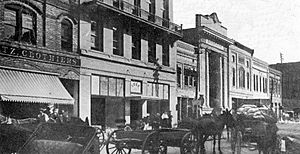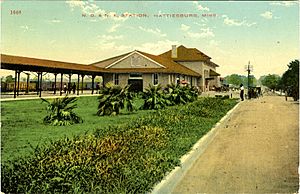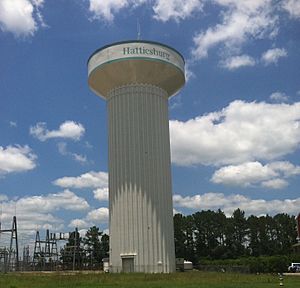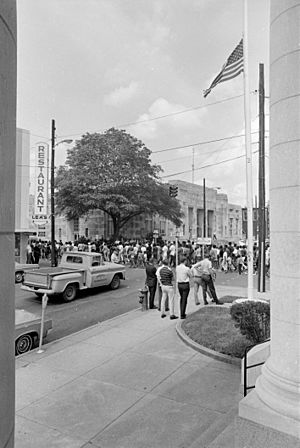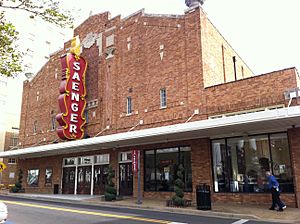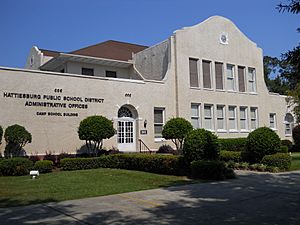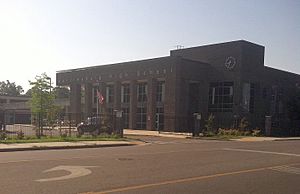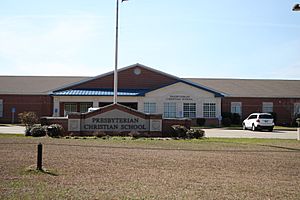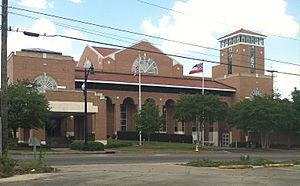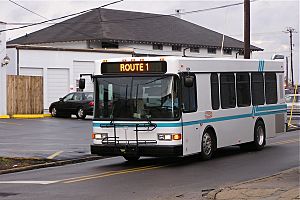Hattiesburg, Mississippi facts for kids
Quick facts for kids
Hattiesburg, Mississippi
|
|
|---|---|
| City of Hattiesburg | |
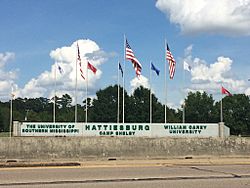 |
|
| Nickname(s):
The Hub City
|
|
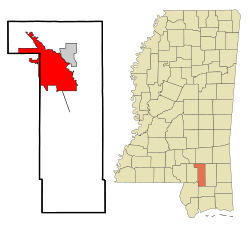
Location of Hattiesburg in the State of Mississippi
|
|
| Country | United States |
| State | Mississippi |
| Counties | Forrest, Lamar |
| Founded | 1882 |
| Incorporated | 1884 |
| Area | |
| • City | 54.47 sq mi (141.09 km2) |
| • Land | 53.43 sq mi (138.39 km2) |
| • Water | 1.04 sq mi (2.70 km2) |
| Elevation | 171 ft (52 m) |
| Population
(2010)
|
|
| • City | 45,989 |
| • Estimate
(2020)
|
48,730 |
| • Density | 858.34/sq mi (331.41/km2) |
| • Metro | 148,839 |
| Time zone | UTC−6 (CST) |
| • Summer (DST) | UTC−5 (CDT) |
| ZIP code |
39401-39404, 39406, 39407
|
| Area code(s) | 601, 769 |
| FIPS code | 28-31020 |
| GNIS feature ID | 0691565 |
Hattiesburg is a city in the U.S. state of Mississippi, located primarily in Forrest County (where it is the county seat and largest city) and extending west into Lamar County. The city population was 45,989 at the 2010 census, with the population now being 48,730 in 2020. Hattiesburg is the principal city of the Hattiesburg Metropolitan Statistical Area, which encompasses Covington, Forrest, Lamar, and Perry counties. The city is located in the Pine Belt region.
Development of the interior of Mississippi by European Americans took place primarily after the American Civil War. Before that time, only properties along the major rivers were developed as plantations. Founded in 1882 by civil engineer William H. Hardy, Hattiesburg was named in honor of Hardy's wife Hattie. The town was incorporated two years later with a population of 400. Hattiesburg's population first expanded as a center of the lumber and railroad industries, from which was derived the nickname "The Hub City". It now attracts newcomers because of the diversity of its economy, strong neighborhoods, and the central location in South Mississippi.
Hattiesburg is home to The University of Southern Mississippi (founded as Mississippi Normal College, for the training of teachers) and William Carey University (formerly William Carey College). South of Hattiesburg is Camp Shelby, the largest US National Guard training base east of the Mississippi River, which hosts up to 100,000 National Guardsmen and Reservists annually.
Contents
History
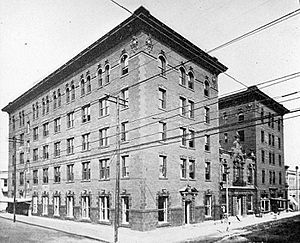
What is now Hattiesburg was previously inhabited by the Choctaw Native Americans. Between 1763 and 1783 the area that is currently Hattiesburg fell under the jurisdiction of the colony of British West Florida. The area switched to being under the jurisdiction of the newly created United States of America after 1783 and was obtained by the United States from its Native American inhabitants under the terms of the Treaty of Mount Dexter in 1805. After the treaty was ratified, European-American settlers began to move into the area.
Hattiesburg is positioned at the fork of the Leaf and Bouie Rivers, and was founded in 1882 by Captain William H. Hardy, a civil engineer.
The city of Hattiesburg was incorporated in 1884 with a population of approximately 400. Originally called Twin Forks and later Gordonville, the city received its final name of Hattiesburg from Capt. Hardy, in honor of his wife Hattie.
In 1884, a railroad — known then as the New Orleans and Northeastern — was built from Meridian, Mississippi, through Hattiesburg to New Orleans. The completion of the Gulf and Ship Island Railroad (G&SIRR) from Gulfport, Mississippi, to Jackson, Mississippi, ran through Hattiesburg and ushered in the real lumber boom in 1897. Though it was 20 years in the building, the G&SIRR more than fulfilled its promise. It gave the state a deep water harbor, more than doubled the population of towns along its route, built the City of Gulfport and made Hattiesburg a railroad center. In 1924, the G&SIRR operated as a subsidiary of the Illinois Central Railroad but lost its independent identity in 1946.
Hattiesburg gained its nickname, the Hub City, in 1912 as a result of a contest in a local newspaper. This suggestion came because the city was the intersection of a number of important rail lines. Later the city also became the intersection of U.S. Highway 49, U.S. Highway 98 and U.S. Highway 11, and later, Interstate 59. Hattiesburg is centrally located less than 100 miles from the state capital of Jackson as well as the Mississippi Gulf Coast, New Orleans and Mobile, Alabama.
The region around Hattiesburg was involved in the nuclear arms race of the Cold War. In the 1960s, two nuclear devices were detonated in the salt domes near Lumberton, Mississippi, about 28 miles southwest of Hattiesburg. Extensive follow-up of the area by the EPA has not revealed levels of nuclear contamination in the area that would be harmful to humans.
Throughout the 20th Century, Hattiesburg benefited from the founding of Camp Shelby (now a military mobilization center), two major hospitals, and two colleges, The University of Southern Mississippi and William Carey University. The growing metropolitan area that includes Hattiesburg, Forrest and Lamar Counties, was designated a Metropolitan Statistical Area in 1994 with a combined population of more than 100,000 residents.
Despite being about 75 miles (121 km) inland, Hattiesburg was hit very hard in 2005 by Hurricane Katrina. Around 10,000 structures in the area received major damage of some type. Approximately 80 percent of the city's roads were blocked by trees and power was out in the area for up to 14 days. The storm killed 24 people in Hattiesburg and the surrounding areas. The city is strained by a large influx of temporary evacuees and new permanent residents from coastal Louisiana and Mississippi towns to the south, where damage from Katrina was catastrophic.
The City is also known for its police department, as it was the first — and for almost a decade the only — Commission on Accreditation for Law Enforcement Agencies federally accredited law enforcement agency in the State of Mississippi. The department is serviced by its own training academy, which has traditionally been one of the most difficult basic academies in the country with over a 50% attrition rate.
The Hattiesburg Zoo at Kamper Park is a longstanding tourist attraction in the city.
In 2011, Hattiesburg Historic Neighborhood District was named one of the "Great Places In America," to live by the American Planning Association. Places are selected annually and represent the gold standard in terms of having a true sense of place, cultural and historical interest. The twenty-five-block neighborhood has one of the best collections of Victorian-era houses in Mississippi with more than ninety percent of the houses substantially renovated and maintained. The Hattiesburg Historic Neighborhood District [HHNA] was Hattiesburg’s first historic district added to National Register of Historic Places in 1980. The Historic Neighborhood District is also part of a Historic Conservation District and protected by Historic Hattiesburg Design Guidelines.
In 2013, the Hattiesburg Historic Neighborhood District celebrated the 38th Annual Victorian Candlelit Christmas and Holiday Tour of Homes. During the two nights of the Victorian Candlelit Christmas, the sidewalks are glowing with thousands of candles in white bags lining the sidewalks. Christmas carolers from the three churches, Sacred Heart, Court Street Methodist and Bay Street Presbyterian, stroll house to house providing Christmas music while horse-drawn carriages slowly move through the neighborhood taking the visitors back in time.
The Miss Hospitality Pageant began in 1949. Hattiesburg received sponsorship of the state pageant in December 1997. The purpose of the pageant is the identification and presentation of a young and knowledgeable lady to help promote the state in tourism and economic development. Contestants are judged on the following categories: panel interview, one-on-one interview competition, Mississippi speech competition, commercial/black dress competition, and evening gown competition. The 2011 winner was Ann Claire Reynolds who is a junior at University of Southern Mississippi majoring in elementary education and special education.
Hattiesburg is home to the African American Military History Museum. Opened in 1942 to serve African Americans serving at Camp Shelby and now on the National Register of Historic Places. The museum started out as a USO Club location and is the only remaining original club location left in the United States. USO's mission statement is to lift the spirits of America's troops and their families. Exhibits include: Revolutionary War, the Founding of Hattiesburg, Buffalo Soldiers, World Wars I and II, Desegregation, Korean War, Vietnam, Desert Storm, Global War on Terrorism, You Can Be A Soldier, Hattiesburg's Hall of Honor, and World Map. The museum is dedicated to the African American soldiers that have fought for their country from Buffalo Soldiers to Operation Iraqi Freedom.
Civil rights movement
Hattiesburg and the unincorporated African American community of Palmers Crossing played a key role in the civil rights struggles of the 1960s. In 1959, black Korean War veteran Clyde Kennard applied to attend then all-white Mississippi Southern College (today University of Southern Mississippi). He was denied admission on account of his race, and when he persisted, the Mississippi State Sovereignty Commission conspired to have him framed for a crime, for which he was sentenced to seven years in Parchman Prison. For years, National Association for the Advancement of Colored People leaders Medgar Evers, Vernon Dahmer, and other Forrest County civil rights activists fought to overturn the conviction.
Forrest County Registrar Theron Lynd prevented blacks from registering to vote. Thirty percent of the population was black, but less than 1% of them were on the voting rolls, while white registration was close to 100%. In 1961, the U.S. Justice Department filed suit against Lynd and he became the first southern registrar to be convicted under the Civil Rights Act of 1957 for systematically violating African American voting rights.
In 1962, Student Nonviolent Coordinating Committee began one of its first voter-registration projects in Hattiesburg under the auspices of Council of Federated Organizations. By 1964, the Delta Ministry was active in the city. In cooperation with the NAACP and local civil rights leaders, they formed the Forrest County Voters League. In conjunction with the 1963 elections, civil rights leaders organized a statewide "Freedom Ballot", a mock election that demonstrated both the statewide pattern of voting rights discrimination and the strong desire of Mississippi blacks for full citizenship. Despite the serious risk of both physical and economic retaliation, almost half of Forrest County blacks participated, the highest turnout in the state.
January 22, 1964, was "Freedom Day" in Hattiesburg, a major voter registration effort supported by student demonstrators and 50 northern clergymen. For the first time since Reconstruction, an inter-racial protest was allowed to picket the courthouse for voting rights without being arrested. Roughly 100 African Americans attempted to register, though only a few were allowed into the courthouse and fewer still were added to the rolls. Each day thereafter for many months the courthouse protest was resumed in what became known as the "Perpetual Picket."
During Freedom Summer in 1964, the Hattiesburg/Palmers Crossing project was the headquarters for all civil rights activity in the 5th Congressional District and the largest and most active site in the state with more than 90 volunteers and 3,000 local participants. Hundreds of Forrest County blacks tried to register to vote at the courthouse, but most were prevented from doing so. More than 650 children and adults attended one of the seven Freedom Schools in Hattiesburg and Palmers Crossing, three freedom libraries were set up with donated books, and a community center was established. Many whites opposed civil rights efforts by blacks, and both summer volunteers and local African Americans endured arrests, beatings, firings, and evictions.
Forrest County was also a center of activity for the Mississippi Freedom Democratic Party (MFDP) which sent a slate of delegates to the Democratic Convention in Atlantic City to challenge the seating of the all-white, pro-segregation delegates elected by the regular party in primaries in which African Americans could not participate. Victoria Jackson Gray of Palmers Crossing ran on the MFDP ticket against incumbent Senator John Stennis and John Cameron of Hattiesburg ran for Representative in the 5th District. With blacks still denied the vote, they knew they could not be elected, but their candidacies and campaigns advanced the struggle for voting rights.
In 1970, the U.S. Supreme Court ruled against trespass convictions for civil rights protesters in Adickes v. S.H. Kress Co.. The case involved a sit-in at the lunch counter of the S. H. Kress & Co. downtown.
Vela Uniform/Project Dribble nuclear tests
Vela Uniform was an element of Project Vela conducted jointly by the United States Department of Energy and the Advanced Research Projects Agency. Its purpose was to develop seismic methods for detecting underground nuclear testing. The Project Dribble program involved two nuclear detonations. Test SALMON occurred on October 22, 1964, with a 5.3 kiloton yield; test STERLING was detonated December 3, 1966, with a yield of 380 tons. Both detonations took place within Tatum Salt Dome, southwest of the Hattiesburg/Purvis area.
Geography
Most of Hattiesburg is in Forrest County. A smaller portion on the west side is in Lamar County with more of the abundant commercial land added in a 2008 annexation. This consists of first, a narrow stretch of land lying east of I-59, and second, an irregularly-shaped extension into West Hattiesburg. In the 2000 census, 42,475 of the city's 44,779 residents (94.9%) lived in Forrest County and 2,304 (5.1%) in Lamar County.
According to the United States Census Bureau, the city has a total area of 54.3 square miles (140.6 km2), of which 53.4 square miles (138.3 km2) is land and 0.89 square miles (2.3 km2), or 1.63%, is water.
Hattiesburg is 74 miles (119 km) north of Biloxi and 90 miles (140 km) southeast of Jackson, the state capital.
Climate
Hattiesburg has a humid subtropical climate, with short, mild winters and hot, humid summers. Snowfall is extremely rare, but on December 11, 2008, areas around Hattiesburg received 3 to 5 inches (0.076 to 0.127 m)*. As is the case throughout the southern United States, severe thunderstorms can pose a threat, particularly during spring. Such storms spawn frequent lightning, heavy rain, occasional large hail and tornadoes. An EF4 tornado struck the Hattiesburg area on February 10, 2013, between roughly 5:00 p.m. and 5:30 p.m. CST. This tornado formed in Lamar County just west of Oak Grove and quickly increased in size and intensity. Although the most severe damage occurred in the Oak Grove area especially near Oak Grove High School, the tornado continued eastward into Hattiesburg causing widespread EF1-EF3 damage to the southern portion of the University of Southern Mississippi campus and the areas just north of downtown, before heading into neighboring Petal and rural Forrest County. No fatalities but over eighty injuries were reported, which was attributed to the nearly 30 minute tornado warning lead time. The most recent tornado was on January 21, 2017, when an EF3 struck the city early in the morning, killing four and injuring twenty.
| Climate data for Hattiesburg, Mississippi | |||||||||||||
|---|---|---|---|---|---|---|---|---|---|---|---|---|---|
| Month | Jan | Feb | Mar | Apr | May | Jun | Jul | Aug | Sep | Oct | Nov | Dec | Year |
| Record high °F (°C) | 87 (31) |
86 (30) |
99 (37) |
94 (34) |
104 (40) |
106 (41) |
105 (41) |
106 (41) |
103 (39) |
106 (41) |
92 (33) |
90 (32) |
106 (41) |
| Average high °F (°C) | 58.5 (14.7) |
63.5 (17.5) |
69.9 (21.1) |
76.7 (24.8) |
83.5 (28.6) |
88.7 (31.5) |
90.8 (32.7) |
90.8 (32.7) |
86.9 (30.5) |
78.3 (25.7) |
69.4 (20.8) |
60.6 (15.9) |
76.5 (24.7) |
| Average low °F (°C) | 37.5 (3.1) |
40.7 (4.8) |
47.6 (8.7) |
54.5 (12.5) |
63.0 (17.2) |
69.8 (21.0) |
72.4 (22.4) |
72.3 (22.4) |
66.9 (19.4) |
55.6 (13.1) |
46.6 (8.1) |
39.6 (4.2) |
55.5 (13.1) |
| Record low °F (°C) | 4 (−16) |
−1 (−18) |
17 (−8) |
29 (−2) |
38 (3) |
49 (9) |
55 (13) |
55 (13) |
40 (4) |
23 (−5) |
18 (−8) |
4 (−16) |
−1 (−18) |
| Average rainfall inches (mm) | 6.31 (160) |
5.81 (148) |
5.35 (136) |
4.95 (126) |
4.45 (113) |
4.84 (123) |
5.68 (144) |
5.71 (145) |
4.48 (114) |
3.61 (92) |
4.92 (125) |
5.48 (139) |
61.59 (1,565) |
Demographics
| Historical population | |||
|---|---|---|---|
| Census | Pop. | %± | |
| 1890 | 1,172 | — | |
| 1900 | 4,175 | 256.2% | |
| 1910 | 11,733 | 181.0% | |
| 1920 | 13,270 | 13.1% | |
| 1930 | 18,601 | 40.2% | |
| 1940 | 21,026 | 13.0% | |
| 1950 | 29,474 | 40.2% | |
| 1960 | 34,989 | 18.7% | |
| 1970 | 39,648 | 13.3% | |
| 1980 | 40,829 | 3.0% | |
| 1990 | 41,882 | 2.6% | |
| 2000 | 44,779 | 6.9% | |
| 2010 | 45,989 | 2.7% | |
| 2020 | 48,730 | 6.0% | |
2020 census
| Race | Num. | Perc. |
|---|---|---|
| White (non-Hispanic) | 19,172 | 39.34% |
| Black or African American (non-Hispanic) | 24,804 | 50.9% |
| Native American | 89 | 0.18% |
| Asian | 830 | 1.7% |
| Pacific Islander | 28 | 0.06% |
| Other/Mixed | 1,552 | 3.18% |
| Hispanic or Latino | 2,255 | 4.63% |
As of the 2020 United States census, there were 48,730 people, 17,778 households, and 9,165 families residing in the city.
2010 census
As of the 2010 United States Census, there were 45,989 people living in the city. 52.8% were African American, 40.5% White, 0.2% Native American, 0.9% Asian, 0.0% Pacific Islander, 0.1% from some other race and 1.1% from two or more races. 4.3% were Hispanic or Latino of any race.
Religion
In 2010 the Hattiesburg Metropolitan area has an Evangelical Protestant majority with 66,000 members. The Southern Baptist Convention has 85 congregations and 53,000 members. The United Methodist Church has 35 congregations and 9,000 members. The third largest is the Presbyterian Church in America with 5 congregations and 1,518 members.
Arts and culture
Theaters
- The Saenger Theatre was one of the seven built and operated by the Saenger brothers. It is listed on the National Register of Historic Places, and hosts an annual Mississippi Miss Hospitality Competition, along with other productions.
- William Carey Center and Dinner Theater.
- University of Southern Mississippi Theatre Department features original productions and National Theatre Live.
Galleries
- A GALLERY, 134 E. Front Street.
- Hattiesburg Arts Council Gallery at the Hattiesburg Cultural Center, 723 Main Street.
- Lucile Parker Art Gallery. Located in the Thomas Fine Arts Building on William Carey University's Hattiesburg campus. The collection consists of 141 artworks by Lucile Parker, and 17 by Marie Hull. From August to May, the gallery features exhibitions of local, state, and nationally known artists.
- Sarah Gillespie Collection at William Carey University, 498 Tuscan Avenue. This is an extensive collection of twentieth century Mississippi art.
- University of Southern Mississippi Art Gallery.
Museums
- African American Military History Museum, 305 E. 6th Street.
- Mississippi Armed Forces Museum at Camp Shelby.
- Freedom Summer Trails.
- Hattiesburg Area Historical Society Museum, 723 Main Street.
- De Grummond Children's Literature Museum.
Train depot
The Hattiesburg Train Depot was constructed in 1910 by the Southern Railway Company, and was the city's largest and most architecturally significant depot. The City of Hattiesburg purchased the depot and 3.2 acres (1.3 ha) of land from Norfolk Southern Railway in 2000, and began a seven-year, $10 million restoration. The completed depot now functions as an intermodal transportation center for bus, taxi and rail, as well as a space for exhibitions, meetings and special events.
Economy
Hattiesburg is home to several national business branches that hold thousands of jobs across the Pine Belt. It was headquarters to the now defunct International Filing Company and currently hosts branches of Kohler Engines and BAE Systems Inc., as well as Berry Plastics and the Coca-Cola Bottling Company United, Pepsi Cola Bottling Co., and Budweiser Distribution Co. Companies such as Sunbeam (shared with Mr. Coffee, and the Coleman Company) and Kimberly Clark used to manufacture in Hattiesburg.
Regions Financial Corporation operates a large operations center in the city, which employs nearly 500 people.
The main shopping mall is Turtle Creek Mall.
Education
Public education in most of Hattiesburg is served by the Hattiesburg Municipal Separate School District, serving grades K–12. Portions of Hattiesburg are served by Forrest County Schools. Portions of Hattiesburg in Lamar County are zoned to Lamar County School District.
Hattiesburg High School is a part of the Hattiesburg district. North Forrest High School (grades 7–12) is a part of the Forrest school district. Oak Grove High School (grades 9–12) is under the Lamar County School District.
Forrest County Agricultural High School is an independent public high school near Hattiesburg.
Colleges
Hattiesburg is home to the main campuses of two institutions of higher learning: the public University of Southern Mississippi (USM) and the private Baptist-supported William Carey University. Both have campuses in other locations; USM has a campus in Long Beach, Mississippi, and William Carey has campuses in Gulfport, and New Orleans, Louisiana. The Forrest County Center of Pearl River Community College, a public institution, is located in Hattiesburg, with the main campus located in Poplarville, Mississippi.
Private schools
- Sacred Heart Catholic School (grades Pre-K–12)
- Presbyterian Christian School (grades PreK–12)
- School of Excellence (grades K–6) (now Early Learning Center, 6 weeks to Pre-K)
- Lamar Christian School (grades Pre-K-12)
- Bass Christian Elementary (grades K–8)
- Bass Memorial Academy (grades 9–12)
- Central Baptist School (grades K–12)
- Benedict Day School (grades K–8)
- Innova Prep (grades K-12)
- The Adept School
Libraries
Forrest County Public Library serves the city. The library has a location in downtown Hattiesburg as well as in neighboring Petal.
Infrastructure
Transportation
Rail
Amtrak's Crescent train connects Hattiesburg with the cities of New York, Philadelphia, Baltimore, Washington, Charlotte, Atlanta, Birmingham and New Orleans. The Amtrak station is located at 308 Newman Street.
Rail freight service is offered by three Class I railroads: CN to Jackson and Mobile, Kansas City Southern to Gulfport, and Norfolk Southern to Meridian and New Orleans.
Mass transit
Hattiesburg owns and operates the city's mass transit service, HCT, Hub City Transit. HCT offers daily routes to many major thoroughfares. The Intermodal Depot downtown services Amtrak as well as the city transit services. Due to recent growth in passenger transport in the city, HCT is currently planning additional routes and services, including bus service to the suburbs of Oak Grove and Petal.
Air
Hattiesburg-Laurel Regional Airport is located in an unincorporated area in Jones County, near Moselle. It offers daily flights from Hattiesburg to Dallas. The airport also has a business park located on the premises.
The city of Hattiesburg maintains the Hattiesburg Bobby L. Chain Municipal Airport (HBG) in the Hattiesburg/Forrest County Industrial Park. Located four miles south of the city center, the municipal airport provides business and general aviation services for much of South Mississippi.
Highways
 I-59
I-59 US 11
US 11 US 49
US 49 US 98
US 98 MS 24
MS 24 MS 42
MS 42 MS 198
MS 198 MS 589
MS 589
Major local routes
Major east-west roads include: 4th Street, Hardy Street/ US Route 98, Oak Grove Road, Lincoln Road, Classic Drive, 7th Street, and Old MS Highway 42.
Major north-south roads include: Interstate 59, US Route 11/Broadway Drive/Veterans Memorial, West Pine Street, Main Street, US Highway 98, 28th Avenue, Golden Eagle Avenue, 38th Avenue, 40th Avenue, Westover, Weathersby Road, and King Road/Old Highway 11.
Notable people
- Victoria Jackson Gray Adams, educator and civil rights leader
- Fred Armisen, actor, comedian and musician, star of Portlandia
- Steven Barthelme, writer and critic
- Wally Berg, first American mountaineer to summit Lhotse, in 1990
- Raylawni Branch, civil rights activist and nurse educator
- Roger Brent, biologist
- Jesse L. Brown, first African-American naval aviator in United States Navy
- Shelby Cannon, tennis player
- Paul Ott Carruth, NFL player
- Robert Carson, pitcher for New York Mets
- Lewis Elliott Chaze, journalist and author of 10 novels
- Shea Curry, actress
- Vernon Dahmer, civil rights leader killed in Hattiesburg by Klansmen in 1966
- Tyler Dickerson, singer
- Adam Doleac, singer
- Bob Dudley, BP executive in charge of Deepwater Horizon oil spill
- Ernest Duff (1931–2016), businessman, lawyer and Mormon bishop
- Wesley Eure, actor in Days of Our Lives and Land of the Lost
- Woody Evans, writer and librarian
- Barbara Ferrell, Olympic gold and silver medalist in National Track and Field Hall of Fame
- Tim Floyd, basketball coach, University of Texas at El Paso, Iowa State, USC, Chicago Bulls
- Joey Gathright, MLB outfielder 2004–2011
- Todd Grisham, ESPN anchor, former WWE announcer
- Gary Grubbs, actor
- Ray Guy, Oakland Raiders punter in College and Pro Football Hall of Fame
- Charlie Hayes, MLB infielder, 1996 World Series champion
- Melinda Haynes, novelist
- Beth Henley, Pulitzer Prize-winning playwright
- Eddie Hodges, actor and singer
- Clifton Hyde, musician and member of Blue Man Group
- Harold Jackson, NFL wide receiver, 5-time Pro Bowl selection
- Fred Lewis, outfielder for Hiroshima Toyo Carp
- Louis Lipps, NFL Pro Bowl wide receiver, 1984 AFC Rookie of the Year, Pittsburgh Steelers
- Hank Lott, Republican state representative; born in Hattiesburg in 1974
- Jack Lucas, youngest Marine to receive Medal of Honor
- Mark Mann, artist
- Danny Manning, basketball player, NCAA champion for Kansas, 1st selection of 1988 NBA Draft, Olympic medalist, 2-time NBA All-Star
- Walter E. Massey, president of Morehouse College, director of National Science Foundation under George Bush, president of Art Institute of Chicago
- Oseola McCarty, benefactor and winner of Presidential Citizens Medal
- Matt Miller, professional baseball player
- Mississippi Matilda, Delta blues singer and songwriter who, in 1936, recorded four songs for Bluebird Records
- Picasso Nelson, football player
- Jonathan Papelbon, Major League Baseball pitcher, 6-time All-Star
- Van Dyke Parks, musician, songwriter, record producer, actor
- Patrik-Ian Polk, film director, writer, and producer
- Todd Pinkston, NFL player for Philadelphia Eagles
- Stephen Purdy, Broadway musician and vocal teacher
- Johnny Rawls, soul blues singer and guitarist
- Purvis Short, NBA player
- Taylor Spreitler, actress
- Robert L. Stewart, NASA astronaut
- Walter Suggs, professional football player, Houston Oilers
- James Wheaton, actor, director, educator (resident infancy to age 12)
- Webb Wilder, musician and actor
- Iola Williams, politician and activist, first African-American member of the San Jose City Council, founder and former executive director the African American Military History Museum
- Amos Wilson, author and activist
- Henry Winston, Chairman of the American Communist Party (1966-1986) and Marxist civil rights activist
- Craig Wiseman, songwriter
- Walter H. Yates, Jr., major general, U.S. Army
- Walter Young, professional baseball player
Images for kids
See also
 In Spanish: Hattiesburg para niños
In Spanish: Hattiesburg para niños



